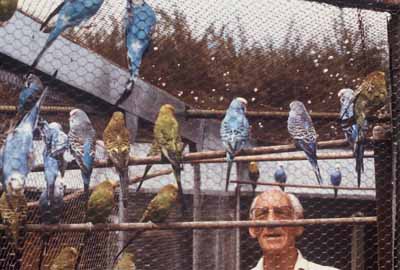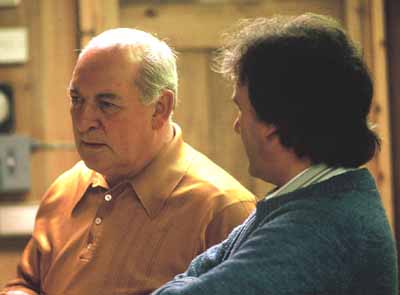Whether you are a pet budgie breeder. or someone new to the hobby, sooner or later you will most likely become aware of bird shows and wonder how your birds would compete.
First step is to attend a show in your area and see first hand how it all is organized and have a look at all the entries and award winners.
From the day most budgerigar breeders
attend their first show thoughts and efforts usually focus on
the million dollar question “How do I breed a bird worthy of
winning the coveted Best-In-Show Award?”.
It’s no different for someone like me,
returning to the hobby after an 8 year break for business and
family commitments. The challenge is there… especially when you
know you start again and immediately compete against the best
Champions around.
It is back to the drawing board and a
chance to use the guidelines that worked in the past to get back
in the winning circle.
Years ago, when I was a teenager in
The other type was those with limited
budgets, who studied the birds, became true breeders, and built
a stud of top quality birds. This Frank said, took longer, but
was the real key to long term success.
It is obvious that the same holds true
today.
Back in
Several years later I moved to

In 1977 I was transferred to
So…. What I have learned is… While there is
no simple answer to this question of how to breed “Best In
Show”, there are some guidelines for the newcomer to the hobby
which will increase your chances and help put you on the road to
success.
The first requirement for success with
Budgerigars is knowledge. And, as with any profession or hobby,
the knowledge and experience necessary for success is not gained
overnight or indeed in a few years. There are several excellent
books written on the subject which will help you gain knowledge.
“The Cult Of The Budgerigar” and “Best In Show” are fine
examples, while “Budgerigar World” magazine and your society
bulletins will expose you to ideas and practices of leading
breeders.
While books and articles are great to pick
up the basics there is no substitute for knowledge gained from
years of experience. Whenever possible attend shows and visit
aviaries. “Pick the brains” of successful breeders. Visit as
many aviaries of top line breeder/exhibitors as possible. They
all have something to offer and you will be surprised how
helpful most will be.
When it comes time to purchase your initial
breeding stock be patient.. and do the homework necessary to
make a wise, well informed decision. The investment you are
about to make can bring years of enjoyment and success, but
beware, it can also bring frustration and despair.
Avoid the temptation to buy every “nice”
bird you see from a variety of sources. Buying birds from too
many sources increases the possibility of them being genetically
incompatible.
Search out a breeder who specializes in
varieties you prefer, one whose birds look similar, one who is
winning on the show bench, and very importantly one who has a
personality that works for you..
When I first got started in the
Hugh Wilson from

Having selected your mentor, visit the
breeder’s aviary if possible. Tell him in advance that you would
like to get started with a few pairs. That can be tough if his
birds are in big demand as Don’s were, but the more I visited
and spent time in his birdroom, the more I learned and in the
process we also became close friends.
Be realistic with your budget. Only you
know what you can afford. But most importantly, don’t make the
mistake of substituting quality of quantity. It’s far better to
start with two or three pair of quality stock than six pair of
inferior quality.
Keep in mind that your success in breeding
winners with the birds you select is almost as important to the
seller as it is to you. If you are successful on the show bench
you will sell your excess stock… but your success will ensure he
does too, assuming you tell others about the foundation of your
birds. Don often joked that I was his best advertisement around
as everyone knew our winning birds were from Langell bloodlines.
Assuming the fancier you have selected has
a reputation for success and honesty, allow him to make some
suggestions on suitable pairings. The fancier knows how his
birds breed and will pair them up as he would to have the best
chance of success.
While it is often possible to purchase an
outstanding cock, a quality breeding hen is “gold”. There is a
saying that you have to breed your own good hens. Be prepared to
take a well bred hen from the same bloodline which may not be as
visually .pleasing as the cock.
The cocks you select should have good size,
desirable head qualities and depth of mask while the hens should
have good length and mask. Avoid small spotted hens as they tend
to pass this characteristic to their offspring.
While it is quite acceptable to purchase a
two or three year old cock which is a proven breeder, one is
advised to buy current year hens whenever possible. The cocks
you bring in will usually have a longer “breeding life” than the
hens which tend to be more temperamental. The fact that a hen
has bred successfully in one aviary does not necessarily mean
she will go to nest in another. The virgin hens should give you
at least two productive seasons and is more likely to accept her
new surroundings.
One exception to this rule is the
outstanding hen a breeder has used successfully for a couple of
seasons and has then discarded from the breeding team. This
usually means she has produced young hens superior to herself.
Such hens are often purchased for a nominal sum because the
owner feels she has served her purpose – and if the price is
right there’s always a chance she’ll produce an outstanding
youngster or two for you. Keep in mind there was a specific
reason the bird was retained in the breeding team for multiple
seasons.
The pairing together of your new arrivals,
especially temperamental hens, is not always easy. I usually
segregate the new birds in a separate room within earshot of my
other birds. Then I pair up the new birds quickly, as soon as
they come into condition. This practice seems to help them
acclimatize to their new surroundings faster and eliminates some
of the stress factors involved in settling in to a new aviary of
strange birds, finding their place in the pecking order, and
adjusting to new procedures and feeding.
The old adage “feed, breed and weed” now
comes into play. A well balanced diet of seed, greens, grit,
minerals, and a high protein supplement or soft food should be
fed throughout the year.
Your goal during your first year is to
produce a satisfactory number of young birds that are “keepers”
to form the nucleus of a “stud” of budgerigars… with emphasis on
the number of hens.
Do not expect to breed winners your first
year. If you do it’s a bonus…. Keep in mind you are working with
someone’s sale birds, not their best… and stay focused on the
goal of breeding enough keepers to work with next season.
In order to achieve these goals avoid the
temptation to overwork your birds, especially the hens. They are
not merely egg laying machines and after a couple of nests
should be rested for several months before they are put up to
work again.
At the end of the first year “keep the
best… and cull the rest”. Discard all the young cocks which have
obvious faults, or who, after their second molt, are not up to
the quality of the cocks you originally purchased.
Be ruthless in culling your cocks retaining
only the very best. Many exhibitors inhibit their progress for
years by breeding with mediocre or “middle of the road” birds.
While hens appear to be able to “mask” or “carry” hidden
desirable qualities I have rarely seen outstanding birds bred
from a poor quality cock.
After your first breeding season you should
also cull all hens with obvious faults eg crossed wings, poor
backline, hinged tail, small spots, but retain the balance to
breed back to your best cocks during the next breeding season.
You may wish to ask the advice of your
mentor when it comes time to determine which birds to keep and
which to sell, especially if you have not yet “developed an eye”
or feel the young are all of equal quality.
Before the second breeding season you
should return to your original source and buy one or two
additional birds. These birds, preferably cocks so they can be
mated to multiple hens, should be superior in quality to your
original purchases.
After the third and fourth breeding season
purchases should only be made to bring in specific features
lacking in your stock ie feather texture, depth of mask, size of
spots, head qualities, or directional feathering.
To increase the genetic compatibility you
should continue to purchase from your original source whenever
possible, or from aviaries where the birds come from similar
bloodlines. When I first got started here I began with birds
from Harold Trethaway, Joe Lastella and Don Langell who all had
birds with Ormerod (

Outstanding birds from new bloodlines are
not always compatible when introduced… and may fail to blend in
and produce the desired features. Over the years I tried
introducing several into the “Langell” families, but the only
one that worked came from Clare & Terry Pilkington in

This procedure has worked for me several
times in the past. First as a teenager in
The one thing I do know from past
experience is.. If you have the patience, and want to really
learn the hobby… just follow this plan year after year and the
overall quality of your birds will steadily improve. It won’t be
long before you are winning classes, sections, divisions, and
even Best In Show.
